The Arcanaeum is a library in the College of Winterhold, an institution and guild that the player visits during the main quest in the 2011 game, The Elder Scrolls V: Skyrim. While the Arcanaeum is not quite like the academic libraries we often see and think of today, it is one of the rare instances in which academic libraries actually appear in video games. In this article, I will explore the function, aesthetic, and staffing of the Arcanaeum and compare it with real-world academic libraries. How would a library patron use the Arcanaeum? What would it be like to work for this magical library? And in which ways does the player’s encounters with the Arcanaeum mirror how academic libraries serve student and research communities?
Skyrim and the College of Winterhold
A continuation of The Elder Scrolls series, Skyrim is a 3D open-world role-playing video game created by Bethesda Game Studios, set in a Nordic-inspired region called Skyrim. The player is the Dragonborn, who is tasked with defeating a dragon prophesied to destroy the world. As the player progresses through the game, they are encouraged to explore, collect, fight, and complete quests. In order to defeat the dragon, the player must acquire the Elder Scroll. During this journey, the Dragonborn will likely find themselves at the College of Winterhold to learn more about the scroll.
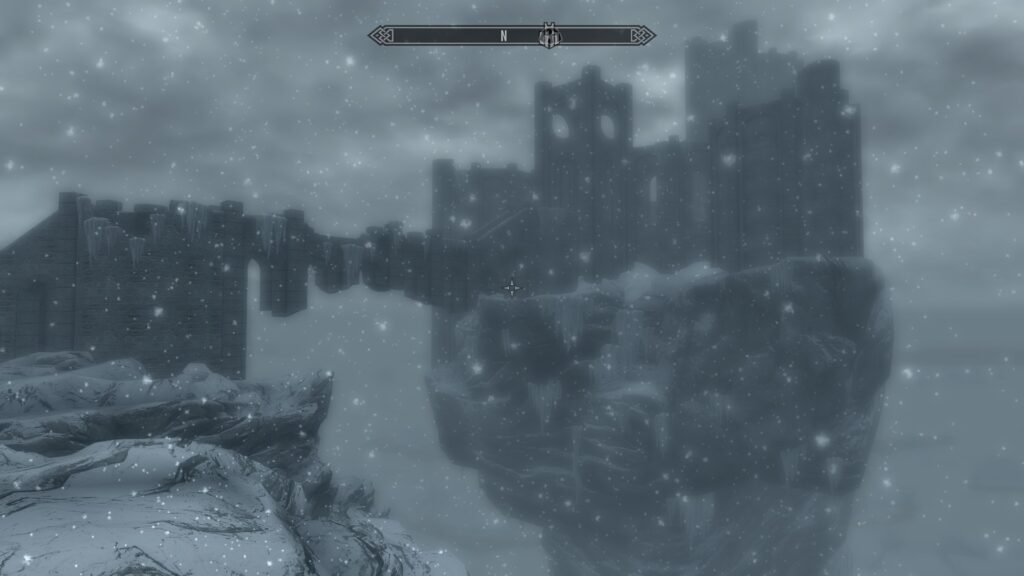
The College of Winterhold is a school and guild of magic that sits on top of a cliff in the Northern snowy city of Winterhold. It is Skyrim’s center of magic study, and was once an academic hub. A damaged bridge connects the College with the local city and the rest of the world. Historically, an earthquake had damaged the local city, but mostly left the College untouched; as a result, the locals now view the College (and magic) with great suspicion.
The campus is made up of halls, the library, dorms, and some hidden areas. When the player is tasked to find the Elder Scroll to defeat the dragon, they can go to the College to learn more. The player comes to the damaged bridge and is stopped. Once the player passes the admissions test (demonstrates proficiency in magic), the player can visit the library.
The Arcanaeum
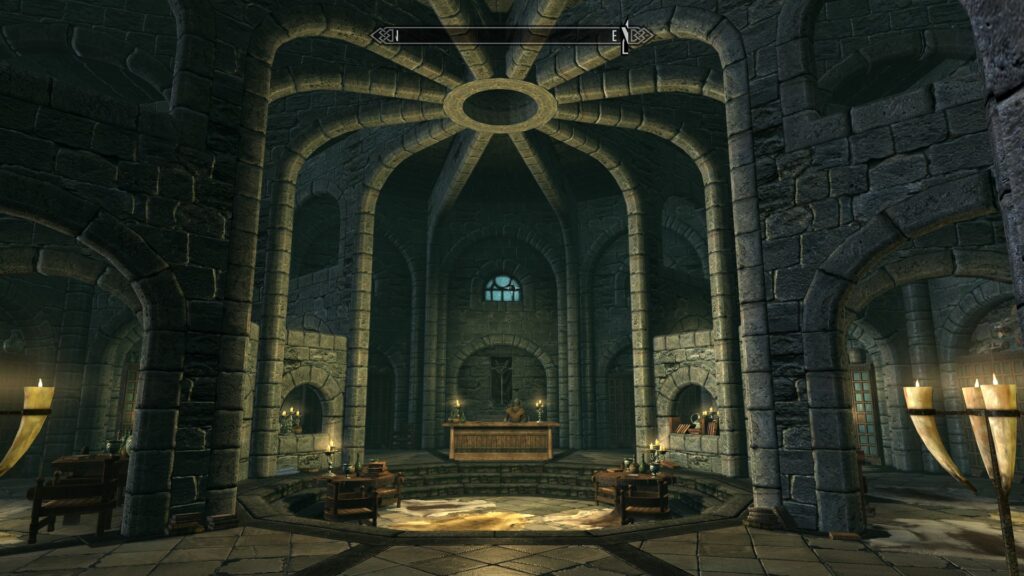
The College’s library, called the Arcanaeum, takes inspiration from Norse culture and European fantasy. The library is located on the second floor of the College and is a dimly lit, round room made with gray stone walls. Along the circular walls are locked bookcases housing unremovable books dating back hundreds of years. As the player walks towards the center of the room, there is another set of round, gray stone walls with window-like gaps. The inner circle makes up a reading room, with wooden chairs and tables. On the tables are books, as well as wine cups, glass bottles, and candles. As the player walks towards the back of the room, they come to the large wooden reference desk where the sole librarian is positioned for most hours of the game. Behind him is a glass case and a flag with the symbol of the school.
In a previous Play the Past article about the game LUNA, I discussed the history of library design, focusing on bookshelves from the Middle Ages. One key feature noted was the anti-theft technology; real-world monastic and university libraries chained books to the bookshelves to stop people from grabbing the books and leaving. This concept can be applied to the locked metal bookcases in the Arcanaeum. As for the lighting, the candles are similar to how medieval monks read and wrote by candlelight in European history (though not something you would likely find in an academic library today). As for the wine, you’ll just find it everywhere in Skyrim; it’s so commonplace that the College of Winterhold should just go ahead and utilize drinks to attract patrons. Though, what ever happened to no food and drink in the library?
In the LUNA article, I discuss “magical libraries.” Magical libraries are places of knowledge that hold power, magic, and wonder. The Arcanaeum, which is a library for what is literally a college of magic, is decorated with monster trophy heads, skulls, and horn candles lend to that trope. It adds a grim, death-and-mortality aesthetic, which is quite different from the whimsical charm in LUNA. There’s also the Orc librarian, the books about magic, and you, the player, who is possibly strolling in with a magic staff, ready to shoot a fireball at any time. Also not typical of real-world libraries.
In terms of function, the Arcanaeum serves the community by supporting the College’s curriculum and research; that’s also the function of real-world academic libraries today. That’s not how all academic colleges start out, though. The first academic library in North America came to be when a man donated his personal collection to a school named Harvard. Because early academic libraries were based on donations, they didn’t grow quickly or consistently. Only in the 1800s did Harvard’s library (as some others) become its own freestanding building, when research and journals became popular and commonplace.
Libraries grew their collections, developed societies and associations, devised standards, and even crafted criteria on which they based their work and value on. They gained budgets, grew in staffing needs, and obtained technologies. The demographic of the libraries changed. In a Play the Past article about Stardew Valley’s library, I wrote about how public libraries in the US were discriminatory against certain genders, races, and classes throughout much of their history, which only changed as ideas of equal rights became more acceptable society. Much is similar for academic institutions and their libraries. Harvard was created in 1638 but it took two hundred years to award the first Black degree recipients (1869), and two of these men were the first Blacks awarded their respective degrees in the whole country. It also took until 1879 for the university to develop a full course of study available to women. This doesn’t begin to discuss all the groups that were prevented from entering higher education. Many universities today are still working through issues of inequity, addressing these issues with controversial policies like affirmative action. With this in mind, back to Skyrim. What is it like to be a person, whether patron or staff, in the College of Winterhold?
The People
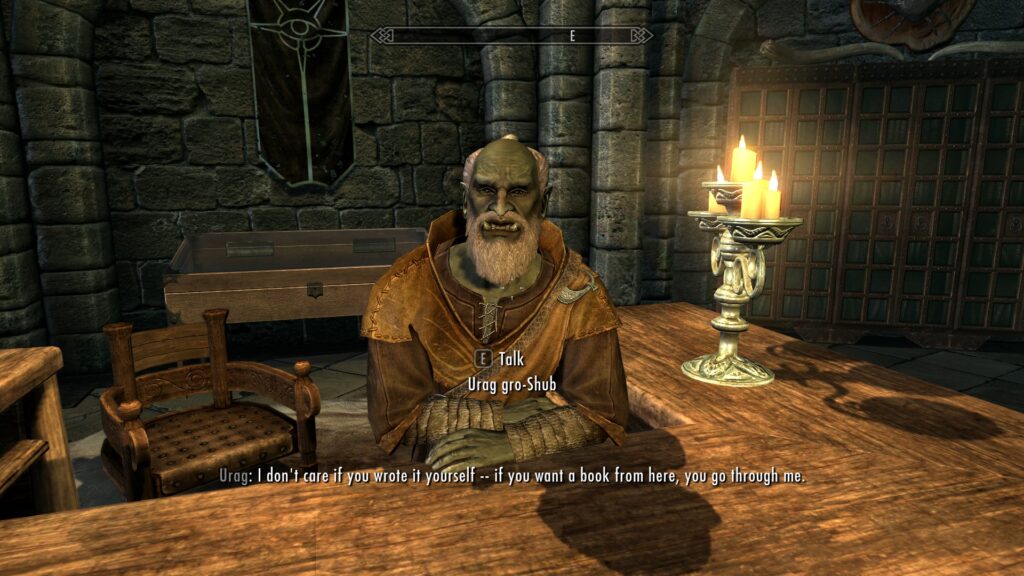
The Arcanaeum is managed by one individual, an old and strict Orc named Urag gro-Shub. He is a mage who watches the library for almost 24 hours a day from his post behind his desk. Gruff and protective, Urag gro-Shub will talk about the books in a way that shows a passion and devotion for the resources he oversees. For the main quest line, the player can ask him about the Elder Scroll.
Some of this Orcish librarian’s responsibilities are similar to real-world academic librarians. For example, Urag gro-Shub gives lectures. Academic librarians are often brought into the classroom to teach students how to use the university database, citation, research practices, etc. Some university libraries employ librarians with topic specialties to help students with research (like law, science, history, etc.). If you were a student looking to write a paper on the history of healing magic in Skyrim, or a scholar hoping to go on a journey to find a lost text, you would likely have to ask Urag gro-Shub for help to find books on the topic. Some academic librarians are also professors who teach library students, to pass on the skill. Can you imagine Urag gro-Shub with an intern? The player can eventually become the Arch-Mage of the College of Winterhold and go on quests for Urag gro-Shub to collect rare books and manuscripts. These quests are similar to the collection development process described in the Spiritfarer post. As a college staff member, the player helps build the library collection through acquisition. In terms of gameplay, this sends the player across the map, encouraging adventuring while triggering new storylines and quests. When the player successfully returns with the acquired text, Urag gro-Shub will pay the player (and occasionally translate ancient text). If it is in contemporary language, the player can read the text themselves. This reveals more in-game lore, while realistically portraying the research tasks that some academic librarians perform. While it is unlikely a university library would pay a librarian for a specific acquisition (it’s just part of the job), the librarians do often get to see new projects and ideas come to light, and even conduct research on their own.
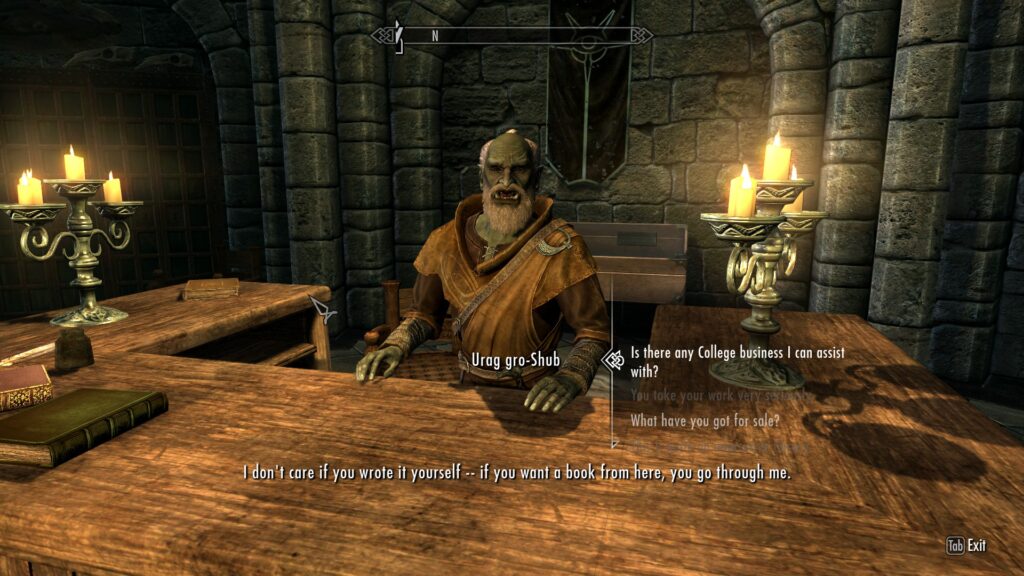
What is inaccurate about this portrayal of academic libraries? For one, academic librarians are people. People shouldn’t work 24 hours a day. Urag gro-Shub is an NPC, but there are other NPCs who get to sleep, so why not him? As one of the editors noted, he’s fulfilling the “vigil” of knowledge trope, perpetually alert and awake. There may be instances where the role requires a library director to be on-call (in case of a fire or flood) but generally, librarians work shifts like most university staff. Urag gro-Shrub never stops working – if he isn’t watching the library, he is giving a lecture. The player will never find Urag gro-Shub sleeping (he’s sitting at best), and that would be absolutely ridiculous for real-world librarians. Some universities may have 24 hour library access, but not all do, and staff certainly aren’t at the reference desk without break.
The second point to address is the staff size. Usually, academic libraries are staffed by a whole department, not just one person. That’s because an academic library has different needs and provides many services. A library must manage digital and print collections, technologies, and facilities. Academic libraries also provide services such as research, instruction, scholarly communications, and publishing, while also adapting their collections to student needs, upholding preservation processes, improving user experience, and providing media services. Who are the people who do all of these tasks? Academic librarians! In addition, the library may have its own administrative, HR, budget, and fundraising requirements, separate from the rest of the university.
Granted, the Arcanaeum is more or less one big room (much like the first academic libraries in the U.S.) whereas many contemporary academic libraries are whole floors or even whole buildings. Some universities or university systems are so big, they have multiple library buildings. On the flip side, some universities have mostly online constituents and thus digital resources; in those cases, it may make sense to have less staff and take up only a few rooms, or perhaps a floor of a college building. Since online resources are 24/7 hours (that is, students can access databases and digital resources at any time), it almost makes Urag gro-Shub seem like a robotic computer. What does that say about how people see real-world librarians?
The College of Winterhold only has a handful of students, and scholars who likely travel, so there may not be as big of a need for a library department. They don’t need computer labs or printers, and based on the number of NPCs, the handful of seats around the library are enough. The Arcanaeum is a scaled down form of a physical academic library, likely to keep it simple for the player and because it is lore-appropriate, but it is worth thinking about all that goes into keeping a real-world academic library functioning.
In a fantasy world like Skyrim, it wouldn’t be strange to find Orc librarians or Khajiit (humanoid cat) mages. Because race is an essential part of world-building, interactions between races are also present. In Skyrim, the region is in a civil war. The war was a result of complex in-game history with multiple sides taking different political and religious views. It is no surprise that the different sides also view non-humans (Orcs, Khajiit, elves, etc.) with varying degrees of acceptance. Racism and religious discrimination motivate some of the violence in the game.In the Skyrim universe, Nords are the main race a player engages with. Nords see magic with suspicion. Some find magic weak and cowardly, and prefer to fight with weapons and muscle. One side of the civil war, the Stormcloaks, explicitly discriminate against non-Nords. In their main city of Windhelm, the Stormcloaks force dark elves to live in slums. They seek to preserve their Nordic way of life, including their religious practices, and see themselves as the “true” people of Skyrim who are fighting for religious freedom.
With this history and current event as the backdrop, how does the College of Winterhold and its library treat its students?
Despite the discrimination in Skyrim, the College accepts magic users regardless of race, including a Khajiit, Nord, and a dark elf. Though some races have more affinity with magic than others, the College seemed open to taking students despite their backgrounds. Based on Urag gro-Shub’s dialogue, if you were a student, he would care more about how you treat the books than whether or not you were a Khajiit. The player, regardless of the race chosen during character building, can become Arch-Mage. Notably, the historic founder and Arch-Mage of the College was a Nord.
Real-world academic libraries and academic institutions are no strangers to the conversation about race or other classes. When it comes to the student body and staff, institutions can and should create policies related to diversity, equity, and inclusion to enhance the library experience. Libraries can strive for and account for diversity, not only in the student body, but also in staff and scholarly communications, though it can be a challenging task when the ivory tower upholds certain classes, the way some Nords see themselves in Skyrim. But that’s a topic for another day.
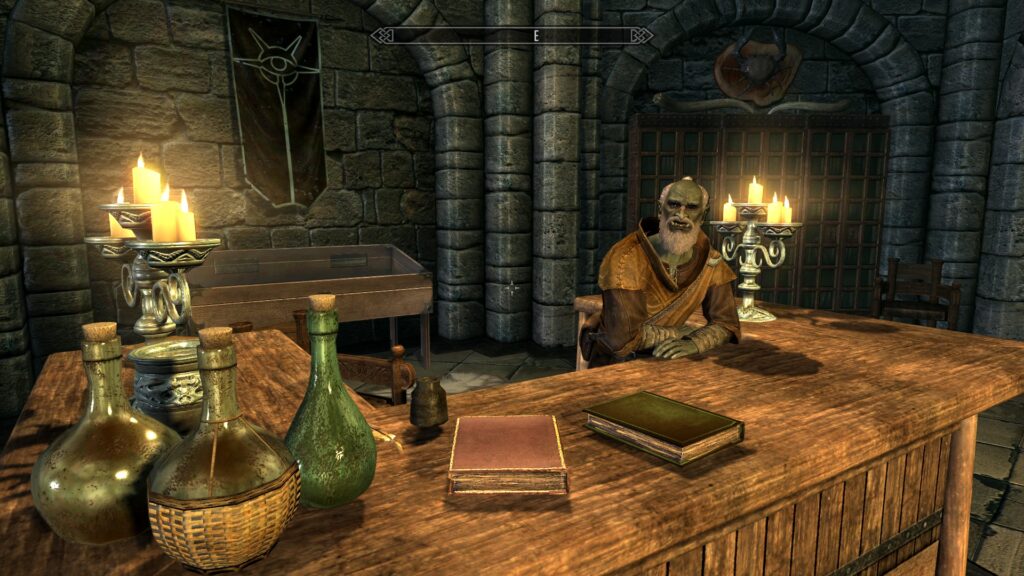
While the Arcanaeum and the College of Winterhold are places in a world of fantasy, their existence as an academic institution in a video game is a rare opportunity to compare an in-game academic library with real-world instances. Though the Arcanaeum is missing a lot of features, staff, and resources, there are some core concepts about the purpose of the academic library that are conveyed. The academic library serves the college, not only the students but also the scholars and researchers. The library houses information, and has staff that protects and grows that collection of information. The institution and the library are not immune to current events, politics, or culture, and how the institution reacts to those variables is an indication of the values the institution seeks to promote in society. And with the current drive to extend 24/7 online library services to students and researchers, are academic libraries (and other contemporary knowledge-curating institutions) paying some oblique homage to Urag gro-Shub, the Orc librarian of the Arcanaeum, tireless vigil of magical knowledge? Who will assist you in your quest for advanced knowledge, hidden in the masses of the library’s dusty volumes and arcane records?
References
American Library Association. “Academic Libraries.” Text, July 21, 2016. https://www.ala.org/educationcareers/libcareers/type/academic.
Ford, Anne. “Libations in the Library.” American Libraries Magazine, March 1, 2019. https://americanlibrariesmagazine.org/2019/03/01/libations-library-alcohol-friendly-events/.
Fouracre, Paul. “Lights, Power and the Moral Economy of Early Medieval Europe.” Early Medieval Europe 28, no. 3 (August 2020): 367–87. https://doi.org/10.1111/emed.12409.
Hathcock, April. “Racing to the Crossroads of Scholarly Communication and Democracy: But Who Are We Leaving Behind?” In the Library with the Lead Pipe. Accessed December 10, 2021. https://www.inthelibrarywiththeleadpipe.org/2018/racing-to-the-crossroads-of-scholarly-communication-and-democracy-but-who-are-we-leaving-behind/.
Kung, Janice Y., K.-Lee Fraser, and Dee Winn. “Diversity Initiatives to Recruit and Retain Academic Librarians: A Systematic Review.” College & Research Libraries, January 8, 2020. https://doi.org/10.5860/crl.81.1.96.
Padraic, Carlin. “American History Harvard University.” ABC-CLIO, 2022. https://americanhistory-abc-clio-com.i.ezproxy.nypl.org/Search/Display/253641?terms=first+college&sTypeId=2.
Payne, Allison. “LibGuides: ACRL Equity, Diversity and Inclusion.” ACRL, January 21, 2022. https://acrl.libguides.com/EDI/home.
Weiner, Sharon Gray. “The History of Academic Libraries in the United States: A Review of the Literature.” Library Philosophy and Practice, July 2005. https://digitalcommons.unl.edu/libphilprac/58/.
Harvard Library. “Who Was the First African American to Graduate from Harvard?” Accessed December 26, 2021. https://ask.library.harvard.edu/faq/82388.
